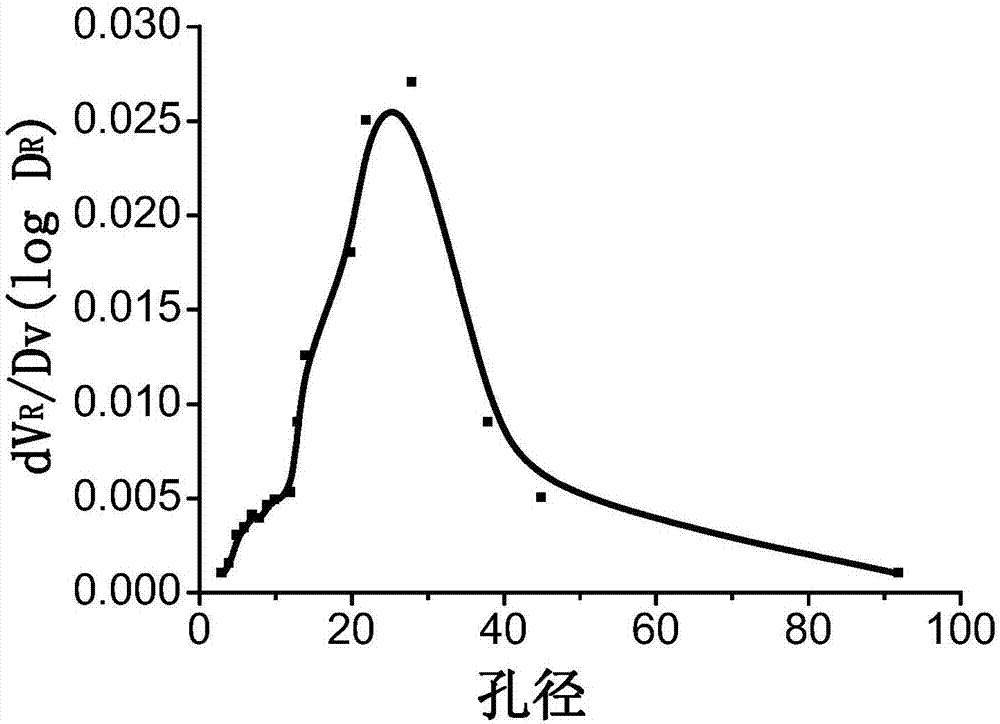Preparation method of magnetic cellulose aerogel
A technology of cellulose aerogel and cellulose solution, applied in the field of preparing magnetic cellulose aerogel, can solve the problems of limited quantity, uneven distribution, aggregation of composite material particles, etc., to achieve stable product performance, improve adhesion strength, The effect of strong adsorption capacity
- Summary
- Abstract
- Description
- Claims
- Application Information
AI Technical Summary
Problems solved by technology
Method used
Image
Examples
Embodiment 1
[0042] (1) Pretreatment of fiber materials: Soak dissolved eucalyptus pulp (provided by Chenhui Paper Co., Ltd.) in distilled water for 12 hours to break the hydrogen bonds between them, and then use a dough mixer to process the fibers after absorbing water. It is easy for the next step of beating operation. The cellulose dissolving pulp was beaten to 30°SR with a PFI refiner;
[0043] (2) Modification of fiber materials: at room temperature, 80 parts by mass of isopropanol and 37.5 parts by mass of deionized water are added to a 1000ml round bottom flask, and then 1 part by mass of NaOH and 1 part by mass of dry eucalyptus are added to dissolve pulp. The round bottom flask was stirred with an electric stirrer at room temperature for 2 hours, and the stirring speed was 240 rpm;
[0044] (3) "Partial dissolution" of fiber material: place the fiber material after step 2) in a round bottom flask, add 1.5 parts by mass of sodium chloroacetate, place the round bottom flask in a c...
Embodiment 2
[0054] (1) Pretreatment of fiber materials: Soak dissolved eucalyptus pulp (provided by Chenhui Paper Co., Ltd.) in distilled water for 12 hours to break the hydrogen bonds between them, and then use a dough mixer to process the fibers after absorbing water. It is easy for the next step of beating operation. The cellulose dissolving pulp was beaten to 35°SR with a PFI refiner;
[0055] (2) Modification of fiber materials: at room temperature, 100 parts by mass of isopropanol and 50 parts by mass of deionized water are added to a 1000ml round bottom flask, then 1.25 parts by mass of NaOH and 1.25 parts by mass of absolute dry eucalyptus are added to dissolve pulp. The round bottom flask was stirred with an electric stirrer at room temperature for 3 hours, and the stirring speed was 250 rpm;
[0056] (3) "Partial dissolution" of fiber material: place the fiber material after step 2) in a round bottom flask, add 1.75 parts by mass of sodium chloroacetate, place the round bottom...
Embodiment 3
[0066](1) Pretreatment of fiber materials: Soak poplar wood pulp in distilled water for 12 hours to break the hydrogen bonds between them, and then use a dough mixer to dissolve the absorbed fibers to facilitate the next step of beating. The cellulose dissolving pulp was beaten to 33°SR with a PFI refiner;
[0067] (2) Modification of fiber materials: at room temperature, add 100 parts by mass of methanol and 30 parts by mass of deionized water into a 1000ml round bottom flask, then add 1 part by mass of NaOH and 1.25 parts by mass of absolute dry poplar pulp . The round bottom flask was stirred with an electric stirrer for 2.5 hours at room temperature, and the stirring speed was 250 rpm;
[0068] (3) "Partial dissolution" of fiber material: place the fiber material after step 2) in a round bottom flask, add a DMAC / LiCl mixed solution with a solute content of 2.5 parts by mass, place the round bottom flask in a constant temperature oil bath Heat and stir in the pot for 5.5 ...
PUM
| Property | Measurement | Unit |
|---|---|---|
| Size | aaaaa | aaaaa |
| Compressive strength | aaaaa | aaaaa |
Abstract
Description
Claims
Application Information
 Login to View More
Login to View More - R&D
- Intellectual Property
- Life Sciences
- Materials
- Tech Scout
- Unparalleled Data Quality
- Higher Quality Content
- 60% Fewer Hallucinations
Browse by: Latest US Patents, China's latest patents, Technical Efficacy Thesaurus, Application Domain, Technology Topic, Popular Technical Reports.
© 2025 PatSnap. All rights reserved.Legal|Privacy policy|Modern Slavery Act Transparency Statement|Sitemap|About US| Contact US: help@patsnap.com



